Catocala luciana
Catocala luciana
kah-TOCK-uh-lahMlew-SEE-an-uh
Strecker, 1874
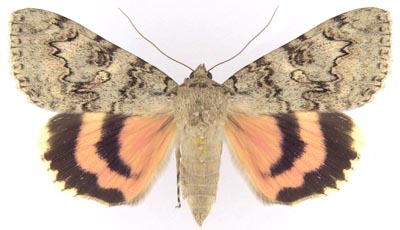
Catocala luciana, Manitoba.
This site has been created by
Bill Oehlke at oehlkew@islandtelecom.com
Comments, suggestions and/or additional information are welcomed by Bill.
| TAXONOMY:
Superfamily: Noctuoidea
Family: Noctuidae
Group: Noctuinina
Subfamily: Catocalinae
Genus: Catocala, Schrank, 1802
| |
MIDI MUSIC
"Moon River"
copyright C. Odenkirk
MIDI CITYON.OFF
<bgsound src="moon.mid" LOOP=FOREVER>
|
DISTRIBUTION:
The Luciana Underwing or Shining Underwing, Catocala luciana
(wingspan: 57-70mm) flies from Michigan and Illinois through
Minnesota and North
Dakota to Montana, south through Colorado to Wyoming and
Kansas.
It is also reported in
Iowa,
Missouri,
Montana,
Nebraska,
New Mexico,
Oklahoma,
South Dakota,
Texas,
Utah and
Wisconsin.
Scott Shaw reports luciana is taken (not common) "on Pole Mountain, in the Medicine
Bow Forest, Wyoming, about 10 miles east of Laramie near I-80 in the mountain willow bogs."
In Canada, it flies in extreme southern parts of Alberta, Saskatchewan and
Manitoba.
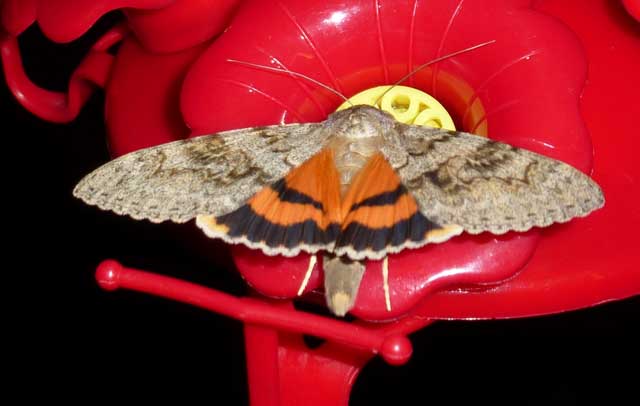
Catocala luciana, Custer, Custer County, South Dakota,
July 30, 2014, courtesy of Lori Balciunas.
Catocala luciana has a pale grey brown forewing with
very distinct antemedial and postmedial lines. However, if identifications are correct, the populations from Canada seem to have fainter lines.
The basal area is grainy grey without dashes. The double am line is very dark on the outside,
lighter on the inside. The median area is also a grainy grey without significant markings.
The reniform spot is boldly outlined in black. The subreniform spot, also boldly outlined,
has an elongated narrow "tail" that seems to open through the
postmedial line. The postmedian line is very black and distinct and begins below the costa.
Note the shape of the pm line just below the subreniform spot, i.e., two "close" teeth before looping back and dropping to the inner margin.
The inner black band of the hindwing does not reach the inner margin. The fringe is checked and sometimes paler (almost yellow) than the salmon
ground colour. There is limited dark scaling in the basal area.
The terminal line is marked by a series of short thin black bars between the veins.
The hindwings are salmon-orange or pink-orange like those of the Mother Underwing. The hindwing fringe is white and pale orange. Very similar in size and markings
to Catocala hermia, and some specimens may be very difficult to separate with confidence. Hermia usually have greyer forewings, and the hingwings of hermia are
bright deep pink, not orange. C. meskei are larger, darker and have darker red-orange hindwings.
Image, Redcliff, Alberta, Canada, courtesy of John Acorn. | 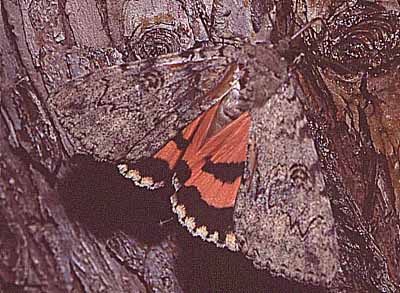 |
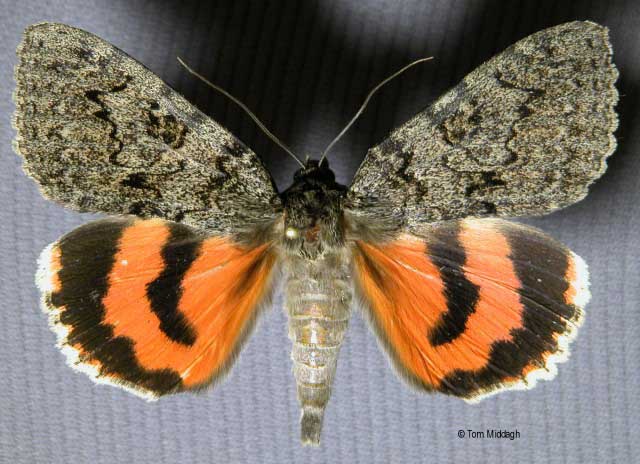
Catocala luciana, Worthington, Nobles County, Minnesota,
57mm, August 9, 2008, courtesy of Tom Middaugh.

Catocala luciana (verso), Worthington, Nobles County, Minnesota,
57mm, August 9, 2008, courtesy of Tom Middaugh.
The C. luciana depicted from Nobles County at 57mm wingspan is either a runt or stated wingspan of 63-68mm is in error.
Having recently (November 2009) received another image from Saskatchewan at 59mm, I am revising wingspan to 57-70mm.
Moths previously listed as Catocala nebraskae are synonymous with Catocala luciana.

Catocala luciana, 60mm, courtesy of Jim Vargo.
FLIGHT TIMES AND PREFERRED FOOD PLANTS:
Catocala luciana flies as a single
generation with moths on the wing from early July into late September.
The Catocala luciana caterpillar feeds on poplar and willow species.
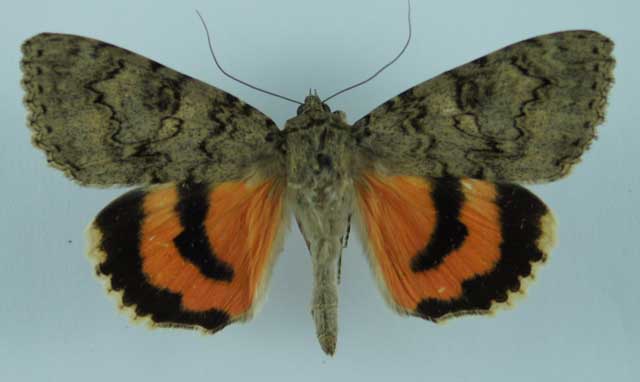
Catocala luciana male, Willow Bunch, Saskatchewan,
70mm, N49 28.711 W105 39.186, Sept 26 2011, 22C, courtesy of Tim Taylor.
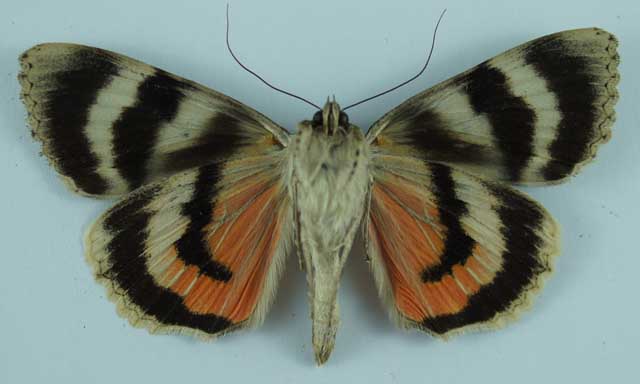
Catocala luciana male (verso), Willow Bunch, Saskatchewan,
70mm, N49 28.711 W105 39.186, Sept 26 2011, 22C, courtesy of Tim Taylor.
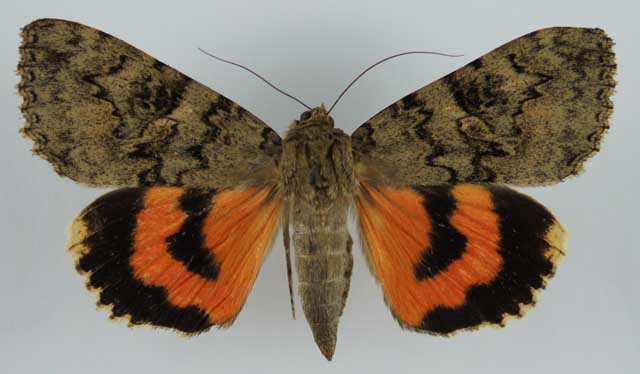
Catocala luciana female, Bengough, Saskatchewan,
70mm, N49 30.268 W105 04.711, Sept 23 2011, 2311ft. 24C, courtesy of Tim Taylor.
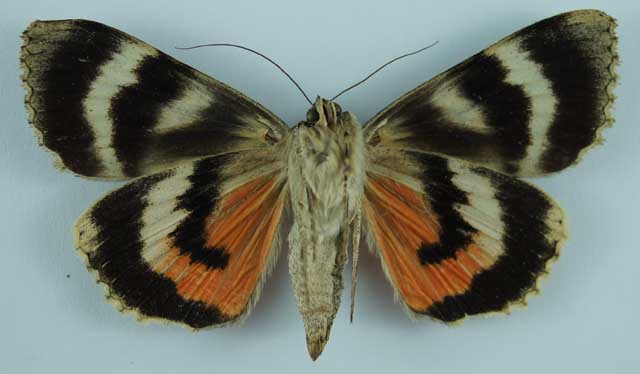
Catocala luciana female (verso), Bengough, Saskatchewan,
70mm, N49 30.268 W105 04.711, Sept 23 2011, 2311ft. 24C, courtesy of Tim Taylor.
ECLOSION:
Adults eclose from pupae formed under leaf litter.
SCENTING AND MATING:
Catocala luciana females emit an airbourne pheromone and males use their antennae to track the scent plume.
EGGS, CATERPILLARS, COCOONS, AND PUPAE:
Eggs are deposited on tree bark in the fall and hatch the following spring.
Mature larvae Image courtesy of | |
Larval Food Plants
Listed below are primary food plant(s) and alternate food plants. It is hoped that this alphabetical listing followed by the common
name of the foodplant will prove useful. The list is not exhaustive, although some species seem very host specific.
Experimenting with closely related foodplants is worthwhile.
Populus.......
Salix
|
Poplar
Willow
|
This page is brought to you by Bill Oehlke and the
WLSS. Pages are on space rented from Bizland. If you would like to become a "Patron of the Sphingidae/Catocala Sites",
contact Bill.
Please send sightings/images to Bill. I will do my best to respond to requests for identification help.
Enjoy one of nature's wonderments: Live Saturniidae (Giant Silkmoth) cocoons.

|

To show appreciation for this site, click on the flashing
butterfly to the left, a link
to many worldwide insect sites. |
Return to Canadian Index
Return to Main Index











